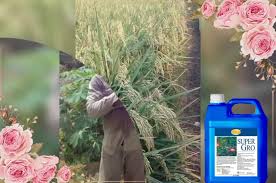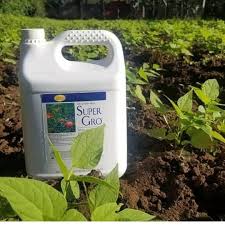Super Gro is a widely used plant growth enhancer that has gained popularity among gardeners for its ability to improve plant health and yield. This liquid fertilizer is specifically formulated to promote robust growth, enhance flowering, and increase overall productivity in various types of plants, including flowers. As gardeners increasingly seek effective ways to nurture their floral displays, the question arises: can Super Gro be effectively used for flower gardening?
In flower gardening, achieving vibrant blooms and lush foliage is a primary goal for many enthusiasts. Super Gro contains a blend of nutrients and growth-promoting substances designed to stimulate root development, enhance nutrient absorption, and promote overall plant vigor.
Its formulation typically includes essential macronutrients like nitrogen, phosphorus, and potassium, as well as micronutrients that contribute to optimal plant health. By providing these key elements, Super Gro can help flowers grow stronger, produce more buds, and exhibit more vivid colors.
One of the standout features of Super Gro is its ability to improve soil quality and fertility. Healthy soil is the foundation of successful gardening, and Super Gro can help replenish depleted nutrients and improve soil structure.
When used in flower gardening, it can create an ideal growing environment for various flowering plants, from annuals like petunias and marigolds to perennials like daisies and roses. This enhanced soil condition allows for better water retention, aeration, and root penetration, all of which contribute to healthier plants and more abundant blooms.
In addition to its nutrient content, Super Gro also acts as a natural growth stimulator. It promotes the development of beneficial microorganisms in the soil, which play a crucial role in breaking down organic matter and making nutrients more accessible to plants. This biological activity is vital for flowering plants, as it helps them thrive in a competitive garden environment. With healthier soil microbiomes, flowers can better fend off diseases and pests, leading to a more resilient garden.
When using Super Gro for flower gardening, it is essential to follow recommended application guidelines to avoid over-fertilization. Applying too much can lead to nutrient burn or negatively affect the delicate balance of nutrients in the soil.
Gardeners should dilute Super Gro as directed, applying it during the active growing season when plants need the most nutrients. Regular applications can be beneficial, especially during flowering periods when plants require additional energy to support bud and bloom development.
Benefits of Using Super Gro in Flower Gardening

1. Increased Flower Production: Super Gro provides essential nutrients that promote vigorous growth, leading to a higher quantity of blooms and extended flowering periods.
2. Improved Plant Health: The balanced nutrient profile in Super Gro enhances overall plant health, making flowers more resilient to pests and diseases.
3. Enhanced Color and Fragrance: Super Gro can intensify the colors of flower petals and improve their fragrance, resulting in more visually appealing and aromatic blooms.
4. Better Root Development: The nutrients in Super Gro support robust root systems, allowing flowers to access water and nutrients more efficiently from the soil.
5. Faster Growth Rates: With the right nutrient balance, flowers treated with Super Gro may establish and grow faster, resulting in earlier blooms.
6. Longer Lasting Flowers: Plants that receive adequate nutrition from Super Gro tend to have stronger stems and healthier leaves, contributing to longer-lasting cut flowers.
Types of Flowers That Can Benefit from Super Gro
1. Roses: Super Gro enhances growth, leading to more vibrant blooms and a longer flowering season, which is essential for both garden displays and cut flower production.
2. Orchids: These delicate flowers benefit from the nutrient-rich composition of Super Gro, promoting healthy growth and abundant flowering.
3. Marigolds: Super Gro can boost the health of marigolds, resulting in more prolific blooms and improved resistance to pests.
4. Sunflowers: Application of Super Gro helps sunflowers grow taller and produce larger, more attractive flower heads.
5. Petunias: These popular garden flowers respond well to Super Gro, showing improved flowering and vibrant colors when appropriately fed.
6. Geraniums: Geraniums flourish with the right nutrients, and Super Gro can enhance their growth, leading to more blooms and healthier foliage.
7. Zinnias: Super Gro promotes lush growth in zinnias, resulting in more vibrant blooms and a longer flowering period.
How Super Gro Enhances Soil Nutrients
1. Nutrient-Rich Formula: Super Gro contains a balanced mix of macro and micronutrients essential for plant growth, including nitrogen, phosphorus, potassium, and trace elements, which are vital for healthy flower development.
2. Soil Microbial Activity Boost: Super Gro encourages beneficial microbial activity in the soil, improving nutrient availability and enhancing soil structure, which supports root health.
3. Improved Nutrient Absorption: The application of Super Gro can improve the soil’s capacity to retain nutrients, allowing plants to absorb them more efficiently and effectively.
4. Enhanced Soil Structure: Super Gro can help improve soil texture, leading to better aeration and drainage, which are critical for healthy root systems.
5. pH Balance Maintenance: The nutrients in Super Gro can assist in maintaining optimal soil pH levels, creating a favorable environment for flower growth.
6. Sustained Nutrient Release: Super Gro provides a slow and steady release of nutrients, ensuring that flowers have access to essential elements over an extended period, reducing the need for frequent applications.
Read Also: 15 Medicinal Health Benefits Of Artemisia Annua (Sweet Wormwood)
Application Methods for Super Gro in Flower Gardening

1. Foliar Spray: Mix Super Gro with water as directed and spray directly onto the leaves of the flowers; this method allows for quick absorption of nutrients through the foliage.
2. Soil Drench: Dilute Super Gro with water and apply it directly to the soil around the base of the plants; this method ensures that nutrients reach the root zone effectively.
3. Fertigation: Incorporate Super Gro into an irrigation system; this allows for even distribution of nutrients while watering, making it a convenient option for larger gardens.
4. Seedling Treatment: When starting seeds or young plants, soak them in a diluted Super Gro solution to promote strong early growth and root development.
5. Transplanting Aid: Use Super Gro in the water when transplanting flowers to reduce transplant shock and encourage faster establishment in the new location.
Recommended Dosage of Super Gro for Flowers
1. General Application: Use a dilution ratio of 1:100 (1 part Super Gro to 100 parts water) for regular applications; this concentration is effective for most flower varieties.
2. Foliar Spray: For foliar feeding, prepare a weaker solution at a ratio of 1:200 to avoid leaf burn, ensuring safe nutrient absorption through the leaves.
3. Heavy Feeders: For flowers that require more nutrients, such as roses and sunflowers, consider applying Super Gro at the recommended dosage of 1:50 (1 part Super Gro to 50 parts water) every two to three weeks.
4. Light Feeders: For less demanding flowers like marigolds or petunias, a dilution of 1:150 (1 part Super Gro to 150 parts water) is sufficient for monthly applications.
5. Container Plants: For flowers grown in pots, use a lower dosage of 1:200 (1 part Super Gro to 200 parts water) to prevent nutrient buildup in the soil.
Timing Your Super Gro Applications for Best Results
1. Pre-Planting: Apply Super Gro to the soil before planting flowers to enhance soil nutrients and support strong growth from the start.
2. Early Growth Stage: Apply Super Gro when plants are establishing their root systems, typically two to three weeks after planting, to promote healthy growth.
3. Budding Stage: Apply Super Gro during the budding phase to provide the necessary nutrients for bloom development and color enhancement.
4. Post-Bloom Care: After flowering, apply Super Gro to support the recovery of the plants and encourage a second flush of blooms, if applicable.
5. Seasonal Applications: In regions with distinct growing seasons, apply Super Gro at the beginning of each growing season to prepare the soil and plants for optimal growth.
Read Also: 15 Medicinal Health Benefits Of Lysimachia clethroides (Gooseneck Loosestrife)
Potential Risks of Overusing Super Gro in Flower Gardens

1. Nutrient Burn: Excessive application can lead to nutrient burn, resulting in leaf tip browning and wilting due to salt buildup in the soil.
2. Soil Imbalance: Overuse may disrupt the natural nutrient balance in the soil, leading to deficiencies in essential elements not provided by Super Gro.
3. Increased Pest Attraction: Over-fertilization can create lush foliage that attracts pests, increasing the risk of infestations in flower gardens.
4. Water Stress: High nutrient levels can affect the plant’s ability to absorb water effectively, leading to stress and poor growth.
5. Environmental Impact: Excessive runoff from over-application can lead to nutrient pollution in local waterways, affecting aquatic ecosystems.
Comparing Super Gro with Other Flower Fertilizers
1. Nutrient Composition: Super Gro often contains a balanced mix of macronutrients and micronutrients, while other fertilizers may focus on specific nutrients like nitrogen or phosphorus, which can affect overall plant health differently.
2. Release Rate: Super Gro typically offers a slow-release formula, providing a steady supply of nutrients, whereas some chemical fertilizers release nutrients quickly, which can lead to rapid growth followed by deficiencies.
3. Organic vs. Synthetic: Super Gro is often considered a more organic option compared to synthetic fertilizers, which may contain harmful chemicals that can affect soil health and biodiversity.
4. Application Frequency: Super Gro may require less frequent applications due to its concentrated formulation, while some other fertilizers might need more regular applications to maintain nutrient levels.
5. Cost-Effectiveness: Although Super Gro might have a higher initial cost, its efficiency in nutrient delivery can lead to better long-term results and savings compared to cheaper fertilizers that require more frequent applications.
Tips for Integrating Super Gro into Your Flower Gardening Routine
1. Start Early: Begin using Super Gro at the start of the planting season to give flowers a nutrient boost right from the beginning.
2. Follow Dilution Guidelines: Always adhere to the recommended dilution ratios to avoid nutrient burn and ensure healthy plant growth.
3. Monitor Plant Health: Regularly check for signs of nutrient deficiency or over-fertilization, adjusting application frequency and dosage as needed.
4. Combine with Other Practices: Integrate Super Gro with practices like mulching and crop rotation to maximize soil health and flower performance.
5. Keep a Schedule: Create a fertilization schedule based on the growth stages of your flowers, ensuring timely applications for optimal results.
6. Educate Yourself: Stay informed about your specific flower varieties’ nutrient needs to tailor your Super Gro applications accordingly.
7. Document Results: Keep a gardening journal to track your flower garden’s response to Super Gro, noting improvements in growth, flowering, and pest resistance.
Do you have any questions, suggestions, or contributions? If so, please feel free to use the comment box below to share your thoughts. We also encourage you to kindly share this information with others who might benefit from it. Since we can’t reach everyone at once, we truly appreciate your help in spreading the word. Thank you so much for your support and for sharing!
Read Also: How to Graft an Avocado Tree to Produce Avocado Fruit
Frequently Asked Questions
We will update this section soon.

